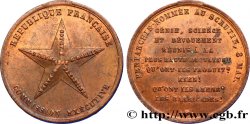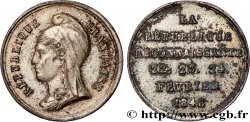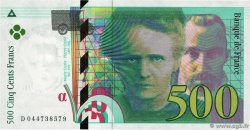Back 1/1
fme_943898 - SECOND REPUBLIC Médaillette, fête de la Concorde
25.00 €(Approx. 28.50$ | 21.25£)
Quantity
Add to your cart

Type : Médaillette, fête de la Concorde
Date: 1848
Metal : brass
Diameter : 28,50 mm
Orientation dies : 12 h.
Weight : 5,70 g.
Edge : lisse
Puncheon : sans poinçon
Coments on the condition:
Patine hétérogène, en partie argentée au revers, taches noires d’oxydation, rayures au revers. Jolis restes de brillant
Catalogue references :
Obverse
Obverse legend : REPUBLIQUE FRANÇAISE.
Obverse description : Deux faisceaux de licteurs et deux drapeaux croisés avec une équerre et une poignée de main (FOI), surmontés par un bonnet phrygien. Inscription circulaire.
Reverse
Reverse legend : LIBERTE EGALITE FRATERNITE // FÊTE / DU CHAMP / DE MARS / 14 MAI / 1848 / *.
Reverse description : Inscription circulaire et en cinq lignes.
Commentary
Diamètre sans bélière : 24,50 mm.
Le 21 Mai 1848, Le Champ de Mars accueille la fête de la Concorde qui rassemble les corporations de Paris. A cette occasion défilent les légions de la garde nationale, de la garde mobile (corps militaire professionnel créé au lendemain de la Révolution de Février, recruté dans la jeunesse populaire). Un mois plus tard éclate l'insurrection de Juin.
Le 21 Mai 1848, Le Champ de Mars accueille la fête de la Concorde qui rassemble les corporations de Paris. A cette occasion défilent les légions de la garde nationale, de la garde mobile (corps militaire professionnel créé au lendemain de la Révolution de Février, recruté dans la jeunesse populaire). Un mois plus tard éclate l'insurrection de Juin.








 Report a mistake
Report a mistake Print the page
Print the page Share my selection
Share my selection Ask a question
Ask a question Consign / sell
Consign / sell
 Full data
Full data














